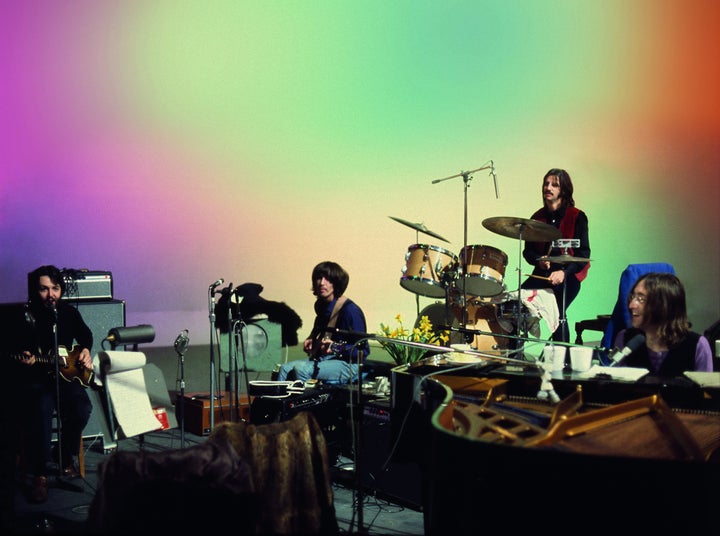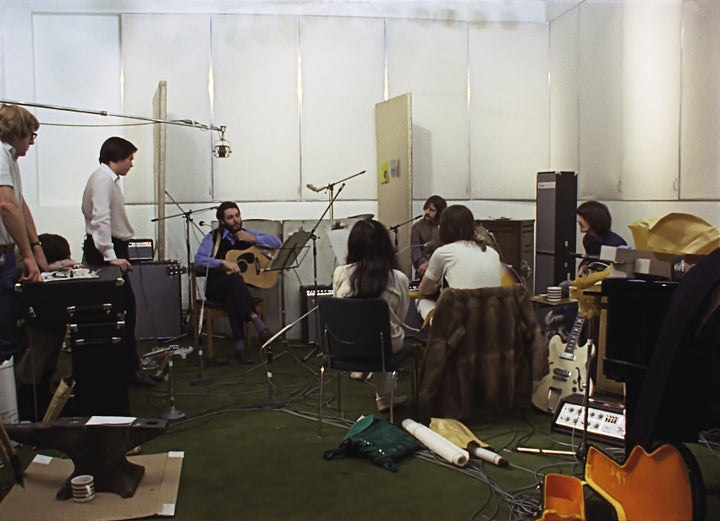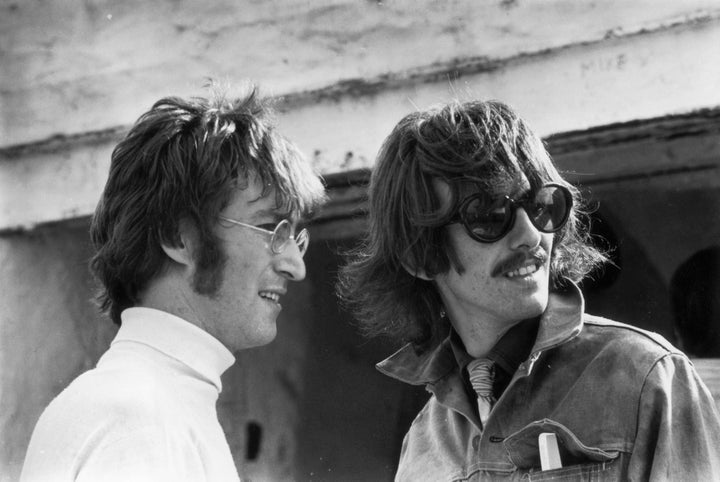
After watching “The Beatles: Get Back,” Peter Jackson’s highly anticipated seven-hour-plus docuseries on Disney+, you’ll almost feel like you played a part in recording “Let It Be.”
That’s due in large part to the film’s sense of intimacy and, no doubt, it’s length. Culled together from 60 hours of footage and 150 hours of unheard audio that was originally recorded in 1969 by director Michael Lindsay-Hogg for his documentary, “Let It Be,” we see the Beatles in the thick of the creative process and seriously contemplating a breakup.
Beatles fans have long believe that the two-week recording process of “Let It Be” ― and rooftop performance it culminated in ― was fractious and argument-ridden and one of the driving forces behind their breakup. (It’s been rumored that John Lennon and George Harrison came to physical blows on the day a frustrated Harrison walked out of the studio. In Jackson’s doc, we see the two men deny it.)
And if you’ve seen Lindsay-Hogg’s “Let It Be,” it’s easy to believe the recording process was pure hell; the cinéma vérité breakup flick is full of scowls and creative arguments. It’s warts and all, but mostly just warts. In “The Beatles: Get Back,” Jackson features many of those tense moments, but he also reintroduces footage that shows how much genuine fun the boys were still having while collaborating in 1969.
“If you’re a fan of the process (and not even necessarily a big fan of the Beatles), this doc is for you.”
Part of the fun of Jackson’s three-part film is the sense of jeopardy, even if you know how it ends: Given how little material they have, how in the hell are they going to wrap things up and make it to that famous rooftop concert on that cold January lunchtime in 1969?
The other fun part, though ― at least if you’re a creative type and collaborator ― is watching the Beatles tinker around and build these now-iconic songs from scratch. If you’re a fan of the process (and not even necessarily a big fan of the Beatles), this doc is for you.
Below, HuffPost highlights 10 things we learned about collaboration from watching the band do their thing in “The Beatles: Get Back.” (In the spirit of collaboration, we got a little help from our friends: organizational psychologists and Beatles podcast hosts who had some thoughts to share.)
1. Your work doesn’t have to be perfect at first go.
One of the most refreshing parts of the doc is the revelation that even the Beatles at their creative peak started off with some clunkers and finessed them into brilliant, lasting earworms we know and love today.
The scrappy first take off “I Got a Feeling” has nothing on the rollicking, perfect last take. McCartney good-naturedly grimaces at how off-key Lennon is on an early version of the “Abbey Road” tune “Polythene Pam.” The songs are in iffy states, but it doesn’t matter. What matters is that it all gets recorded; there will be time to refine and shine them up later.
Take, for instance, a scene in Episode 3 where Harrison attempts to work out the lyrics for a nascent version of another “Abbey Road” track, “Something.”
“Something in the way she moves / attracts me like …” he says, fumbling for the right word.
Lennon’s sound advice? “Just say whatever comes into your head each time — ‘attracts me like a cauliflower’ [for instance] — until you get the word.” (Of course, the line would eventually be “like no other lover.” It’s a little hard not to scream that at the screen while watching that bit.)
2. A leadership vacuum can easily create a sense of chaos.
The shadow of Brian Epstein, the manager who discovered the Beatles and guided them to superstardom before dying of an accidental drug overdose in 1967, looms large in the doc. McCartney explicitly states that the band is in deep need of a “central daddy figure” to keep them on task, but he’d rather it not be him.
The first week of recording is mostly a bust because of this leadership vacuum, with Lennon ― McCartney’s long-standing creative partner ― basically asleep at the wheel, Harrison increasingly frustrated that his songs are being passed over, and poor McCartney struggling to be the point person for every third party on set, whether it’s Lindsay-Hogg, engineer Glyn Johns or Denis O’Dell, the head of Apple Films.
In January 1969, the Beatles were clearly in dire need of a leader, said Bobby Hoffman, an associate professor at the University of Central Florida who writes about human motivation (and loves the Beatles).
“What ‘Get Back’ shows is that leaderless groups can be lethal in terms of productivity and efficiency,” he said. “I really do think Epstein’s death was a key catalyst to the group’s demise.”
Role definition in the Beatles was very fluid as time passed, Hoffman said: “John started the band and was older and thus a default leader at the start. However, as the group developed, individual identities evolved that were inconsistent with John’s vision.”

3. When someone is taking the lead or taking on the lion’s share of the work, give them credit.
Absent a leader, a beleaguered McCartney takes the reins as taskmaster. The rest of the band feels uneasy about that, too, especially when Macca slips into micromanager mode.
Still, there’s no denying that the album wouldn’t have been completed had it not been for his leadership, patience and creative drive. The reality is, he should have gotten a whole lot more credit for that from his bandmates, said Thalia Reynolds, the co-host of the Beatles podcast “Another Kind of Mind.”
“I think sometimes because McCartney mostly handled the extra responsibility competently, the others may have assumed that it was easy for him, when it clearly wasn’t, causing him to feel frustrated and overwhelmed,” she said. “He complains, ‘I get no support,’ at one point.”
“A little grace and acknowledgment from the others may have gone a long way toward defusing difficult confrontations,” she added.
4. Humor gets you everywhere.
Yes, there’s some slow, sloggy sections of the doc ― no one said being creative geniuses was easy ― but ultimately, one of the biggest joys of the documentary is witnessing how legitimately funny the Beatles were in each other’s presence. It’s hard not to laugh yourself while watching Lennon and McCartney goof off in multiple takes of “Two of Us,” singing through gritted teeth in one take, and in exaggerated British and Bob Dylan-esque accents in others.
When Harrison half-jokingly suggests bringing Dylan in to join the recording process (at this point, Harrison and Dylan are friends), McCartney zings back: “It’s bad enough with four!”
Even Peter Sellers at peak funniness can’t keep up with the boys’ banter when he stops by Twickenham Film Studios to see how the recording sessions are going. (Not great, but at least they’re laughing!)
The takeaway here: All those stupid, silly detours don’t just inject some much-needed levity into the production process, they also oil your creative wheels when you need it the most.
5. Don’t sleep on your George Harrison. (In other words, don’t underestimate a less veteran member of your group.)
One of the more obvious points the doc makes is how truly ostracized and underestimated Harrison was in the winter of 1969. Though he had admittedly taken a back seat on composing for much of the Beatles’ run, by 1969, he was operating at the top of his songwriting game at the mere age of 25.
When the Beatles did finally call it quits for good, Harrison released a critically acclaimed three-disc album, “All Things Must Pass,” which was No. 1 worldwide for weeks.
The title track to Harrison’s album is workshopped in the footage, but never sees the light of day on any Beatles album. Meanwhile, “One After 909,” a toss-away track from McCartney and Lennon’s teenage songwriting days does make the cut. McCartney is particularly dismissive of Harrison’s songwriting, said Will Hines, the host of the podcast “Screw It, We’re Just Gonna Talk About the Beatles.”
“Although Paul would later come to respect George’s work, we see Paul mistakenly treat George like a little brother,” Hines told HuffPost. “He seems unimpressed with his songs, he calls George’s guitar suggestions on ‘Get Back’ cliche. He does not offer any suggestions when George asks for help on the lyrics for ‘Something.’”
Hines said the problem is that “Paul is still thinking of George as the 14-year-old who he brought into the Quarrymen [Lennon’s earlier band] and not the guy who was about to write, ‘Here Comes the Sun.’”
The lesson here is to validate and sing the praises of the more junior members of your team. Otherwise, they might pull a George Harrison and walk out on you.

6. Create alone, hone together.
One of the most magical moments in “The Beatles: Get Back” is watching McCartney take the bare bones of “Get Back” and turn them into a full-fledged song, with some noodling and feedback from Harrison and Starr.
Liane Davey, an organizational psychologist and “teamwork doctor,” thinks it’s a teachable moment for creatives: Generally speaking, kernels of brilliant ideas are more likely to come when you’re working alone, not when you’re together.
“Paul starts with the most basic chords and nonsensical sounds and in about two minutes, the core of the song emerges,” she told HuffPost.
“Once there’s enough of an idea, then you can bring in the team to help make it better,” she explained. “Until you believe in your idea and have a clear vision of it, group dynamics and naysayers are likely to squash it. Create alone, hone together.”
7. Anticipate disagreements when you’re working in a group.
On the eve of recording “Let It Be,” the Beatles were the biggest band in the world, coming off a killer creative roll with the release of both “Sgt. Pepper’s Lonely Hearts Club Band” and “The White Album.”
Sure, there are a lot of petty arguments in the doc, but when you’re collectively working at the top of your game like that, there are bound to be disagreements and subtle (or not so subtle) battles for rank, said Carylynn Larson, an organizational psychologist and leadership coach.
“The stakes were exceptionally high for the Beatles in 1969, and a group like that has a long way to fall if they fail,” she said. “There’s disagreements in every group, but disagreements on top-tier teams often feels like a threat instead of an opportunity, and can more readily bring out threat-based reactions like stonewalling, fault-finding, gatekeeping, self-promotion and arrogance.”
8. Find your Billy Preston. (That is, if things have grown stale, invite a new person into the fold.)
Midway through the recording process, Billy Preston, a piano prodigy who had worked with Little Richard and was friends with Harrison, serendipitously stops by the recording studio, right when the band is in need of a keyboardist.
Preston’s presence provides the Beatles with some much needed structure ― up until this point, they were operating like an aimless garage band ― showing that sometimes, what a collaboration needs most is fresh blood.
“You’ve giving us a lift, Bill,” a grateful McCartney tells Preston. “We’ve been at this for days.”
9. A day off (and a change of scenery) will serve you well.
After Harrison walks off set and hightails it to Liverpool, the remaining Beatles spend a day puttering around and contemplating where they intend to go from there. The next day, they cancel rehearsal. The few days of downtime give the guys some much needed breathing room, and when they meet up with Harrison again, hoping to extend an olive branch, the meeting is constructive.
Moving from the expansive Twickenham Studios to the more intimate setting of Apple Studio is a real game changer, too.
The lesson here? Take your mental health or self-care days while working. And if you start to feel stifled in one space, a change of scenery can do you good.

10. Find your equivalent of the rooftop concert.
Throughout the film, we see the band fight over what songs to do, what the film should be and which songs of Harrison’s they should play, but after the rooftop concert, they’re all smiles and no complaints, Hines said.
“The Beatles needed to perform to find themselves,” he said. “I think any group should stay in touch with what makes them happy. To do the thing they know they are good at.”
In the midst of a similar creative rut? Do as the Beatles did and remember the thing you found success with early on and return to it.
“This will be different depending on what field you’re in, but remembering the thing that made you successful initially and going back to it is so helpful,” Hines said. “In some ways with the Beatles, it feels like if they found a way to play live more the band could have lived on.”
Way to break our Beatle-loving hearts, Hines. On that slightly depressing note, we’ll leave you to go find your personal rooftop concert, whatever that might be.